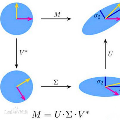In this paper we tackle two important challenges related to the accurate partial singular value decomposition (SVD) and numerical rank estimation of a huge matrix to use in low-rank learning problems in a fast way. We use the concepts of Krylov subspaces such as the Golub-Kahan bidiagonalization process as well as Ritz vectors to achieve these goals. Our experiments identify various advantages of the proposed methods compared to traditional and randomized SVD (R-SVD) methods with respect to the accuracy of the singular values and corresponding singular vectors computed in a similar execution time. The proposed methods are appropriate for applications involving huge matrices where accuracy in all spectrum of the desired singular values, and also all of corresponding singular vectors is essential. We evaluate our method in the real application of Riemannian similarity learning (RSL) between two various image datasets of MNIST and USPS.
翻译:在本文中,我们处理与以下两个重要挑战有关的两个重大挑战:一个是准确的单值分解(SVD),一个是用于快速解决低级学习问题的巨型矩阵的数值级估计;我们使用Krylov子空间的概念,如Golub-Kahan 的多角度化进程以及Ritz矢量,以实现这些目标;我们的实验确定了拟议方法与传统和随机的SVD(R-SVD)方法相比在类似执行时间计算单值和相应单个矢量的准确性方面的各种优势;拟议方法适合于涉及大型矩阵的应用,其中,所有要求的单值的频谱准确性以及所有对应的单个矢量都是必不可少的;我们评估了我们实际应用里曼相似性学习方法的方法,即MNIST和美国PS两个图像数据集之间的两种图像数据集。



